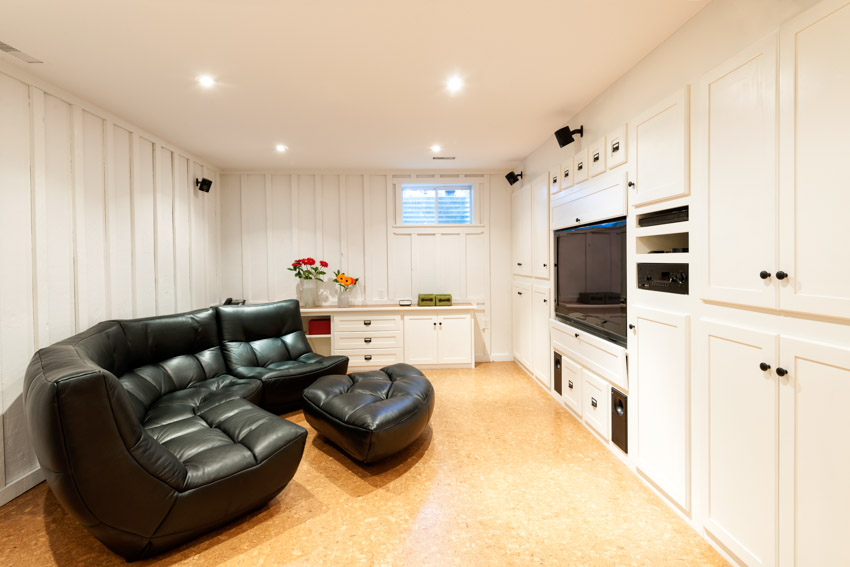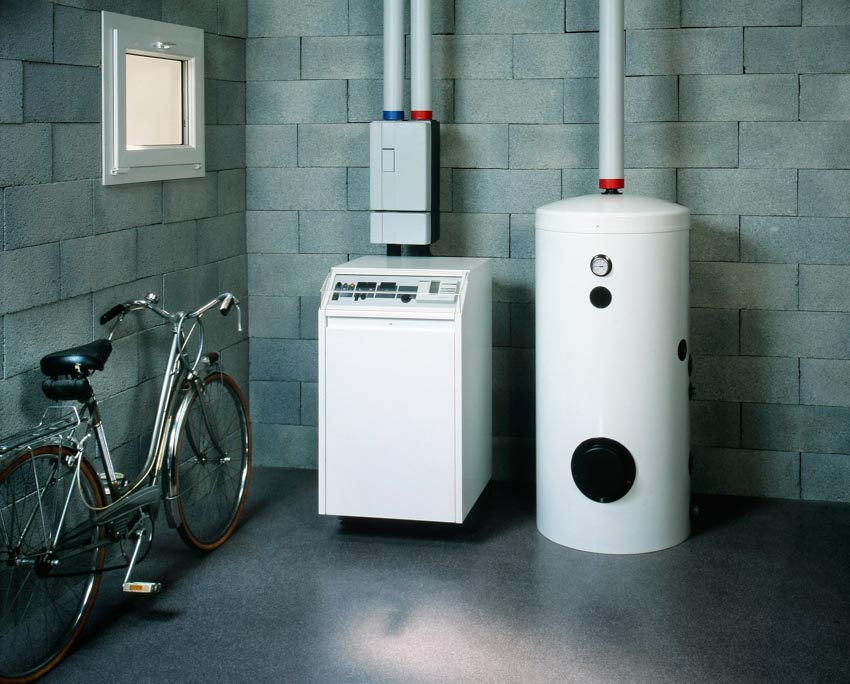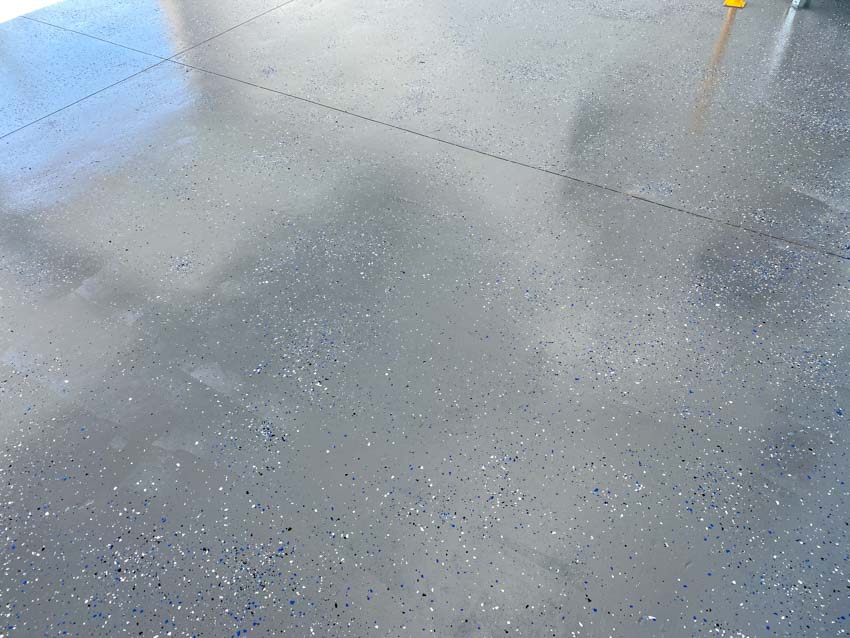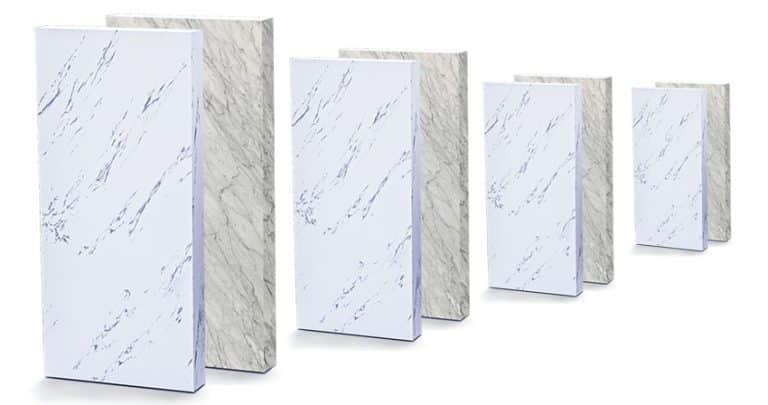Painting A Basement Floor Pros And Cons
Painting the basement flooring may seem like a good idea; however, there are several things to be aware of. Below I share the painting a basement floor pros and cons, including the different reasons I recommend it, costs, types of paint to use, and tips on the best way to do it.

Homeowners use basements for storage and washing in many ways, while others use them for leisure. Whatever function the space serves, treating it like any other portion of your home is critical.
You may find a concrete floor in most unfinished basements. This part is frequently unpleasant in its natural form. Many unfinished basements remain unused because owners are unsure what to do with the area.
However, many methods make an unfinished floor plan more inviting and practical. A fast and cost-effective option to make the atmosphere more ideal for living space—especially for casual purposes such as an entertainment area, workshop, or workout room—is to apply floor paint.
A well-painted basement floor covered with decent area rugs may be valuable for a variety of functions and make the area more comfortable, appealing, and easy to maintain.
Reasons To Paint Basement Flooring
There are several reasons why you need to cover your basement floor. The first and most evident benefit is it will breathe new life into your whole room. In addition, doing so will raise the value of your property.
Basement floor coverings have another essential purpose besides aesthetics: protecting your flooring from harm. Moisture, chemicals, stains, dust, and damage are all resistant to properly fitted coatings. Additionally, sealing your flooring prevents germs and vermin from entering your house via your floors.
Changing up the way a floor looks in a room is among the cool finished basement ideas that can completely revamp the look and feel of a room. There are a lot of different ways that you can do this as well. One way to change up your basement floor is to simply paint it.
Pros Of Painting A Basement Floor
Naturally, every home improvement job comes with its own pros and cons. First, we’ll start with the good news and cover what painting your basement floor can offer you.
• Mitigate Moisture: Basements are infamous for allowing moisture in from all sides due to their underground placement. Moisture entry may cause many issues over time, including mold, mildew, decay, and more.
From above, floor sealing prevents moisture from entering the pores and fissures of your floor. Choosing suitable concrete floor finishes for can give numerous layers of protection against moisture incursion in this manner.
• Improves the room design: Although appearances aren’t everything, most people want to be proud of their homes and enjoy the ambiance they create.
Basement concrete floor paint, at the least, enhances the aesthetic of your flooring by adding color, vitality, texture, and more.
There are a lot of aesthetic benefits to painting your basement floor and the simple appeal of paint over bare cement. The most obvious one is variety. Since you’re painting the floor, your options are nearly limitless if you have the right paint.
• Covers imperfections: With that in mind, it’s also a great way to cover any flat imperfections on your floors like stains from a spill if you use a color dark enough to cover the mess.
• Keep Maintenance to A Minimum: Cleaning your room is essential for maintaining it. Cleaning a bare or damaged concrete floor, on the other hand, is a complex process since dust, grime, oil, and moisture may be difficult to remove from the concrete’s holes.
You may quickly seal these pores and gaps by applying floor paint carefully, making cleaning and routine upkeep a joy.
• Easier to clean: It’s easy to clean too, so it’s a great choice for a high-traffic area like a finished basement or even the potential messes for a stricter purpose like storage.
• Protect the floor: There are also paint options that you can use to add a little more protection to your floors than bare concrete offers. A great choice is to opt for waterproof paint that will help make your cement a bit more resistant to damaging moisture.
• Enhance Safety: If you use this room often, it’s essential to keep it secure. Uneven, cracked, and pitted concrete floors are tripping risks, and they’re also slick (especially when coated in dust).
• It’s critical to reduce these dangers, and polyurea floor coatings or comparable protective floor coatings provide precisely that. These coatings provide an even, plainly visible walking surface, enhancing friction, reducing the danger of slips and falls.
• Inexpensive option: Another benefit to basement floors is that when it comes to materials, it’s a relatively inexpensive project compared to putting down a new layer of flooring. We’ll discuss the cost of painting these floors in more detail later on.
• Better resale value: Each of the advantages, as mentioned earlier, is significant in and of itself. They do, however, add to a larger picture, notably the market worth of your property.
Even if you don’t intend on selling your property anytime soon, valuation is something to think about. If you’re planning to sell your home, renovating the basement walls and flooring might provide a considerable return on investment.
Cons Of Painting Floors In The Basement
Now that we’ve covered some of the benefits of painting a basement floor let’s take a look at some of the cons that come with painting these surfaces.
• Can be a time-consuming project: The biggest disadvantage to consider is that painting these floors isn’t quite the same as repainting a bedroom. It can surprise some homeowners by what a big job it is, and making mistakes can really show in the long run.
• Difficult as a DIY project: While painting basement floors is usually advantageous, the biggest drawback is that it is usually difficult for the ordinary homeowner to undertake on their own.
Frequently, the floor must be prepped, which means it must be clear of dampness, oil, and bumps. An acid etch is required to prevent paint flaking and chipping in certain situations and should be done by a specialist to minimize the health dangers associated with the operation
As such, many homeowners opt to hire a professional for the job which definitely cuts down on the risks associated with taking on a big DIY project as well as equipment costs but does add to the overall cost of labor for the project.
• Need specialized paint: Painting a concrete floor necessitates the use of specialized paint. If the other conditions are good, most so-called porch-and-floor paints will work, but it’s preferable to opt for a particular concrete-floor paint for long-term durability.
• Can create noxious fumes: In addition, since painting floors is often a job done with epoxy paint, you have to consider the fact that this will create a lot of fumes as you work. This can particularly pose a challenge if you have a basement that isn’t well-ventilated.
As such, you’ll want to make sure you have the proper respiratory protection, such as the right masks to make sure you don’t experience adverse effects.
• Can be costly: Painting floors is a complex process that may take days to accomplish. As a result, many homeowners employ a professional to paint their concrete floor, resulting in a home improvement that costs more than simply the cost of the paint.
As long as you make sure that the paint job turns out well, you aren’t run into many problems maintaining most painted basement floors.
Cost To Paint Basement Flooring
The cost of materials and labor will play a significant role in whether you decide to reinforce or leave your basement floor unfinished. The entire cost of installing a basement floor depends on the coating you choose, the surface area of your floor, the extent of the damage, and the contractor you engage.
In most basements, the floor is made of cement or concrete. For this type of flooring as a DIY project, the average cost to paint a basement floor is about $1.45 to $3 per square foot.
For the total cost, you can multiply this average by the square footage of your own floor plan. This cost is for the materials themselves and can vary depending on your chosen paint.
Water-based paint costs about $30-50 per gallon, whereas solvent-based or 100% solid epoxy paint costs between $60 and $200 per gallon. Contractors may charge by the hour or by the square foot for labor.
Overall, a professional coating of a 1,000 square foot basement floor might cost anywhere from $2,000 to $7,000 (including material prices), or roughly $3-10 per square foot.
To save money, you may consider applying coatings yourself. It might only cost a few hundred dollars if you do it yourself (and several hours of your time, of course).
Using 100% solid epoxy or polyurea coatings, on the other hand, is complicated and should be done by a specialist. You risk messing things up and having to undo all of your hard work and start over if you don’t.
As we mentioned, though, there are more facets to these painting a basement floor pros and cons than just the cost of the paint itself.
For instance, if you plan to take on the project as a DIY, you’ll have to make sure you have all of the equipment you need to complete the job as well as the materials for it.
Conversely, if you decide to have your flooring professionally painted, you won’t have to purchase any equipment yourself but you’ll have to pay for the cost of labor which can vary a bit from company to company.
When considering the cost of painting your basement floor, it’s worth considering that this can be a great investment for the future as well. Homes with a painted floors are likely to have a higher market value than a home with a bare surfaces.
What Type Of Paint Is Best For The Floors In the Basement
Professionals and homeowners agree that epoxy paint is the best option for protecting and beautifying a concrete basement floor.
What Do You Use To Paint Flooring In Basements?
Going for epoxy floor paint is the best option for basement flooring. This paint includes a small quantity of epoxy, which helps to provide an extra layer of protection.
Epoxy paint serves as both a sealant and a paint. Instead of evaporation, a chemical reaction hardens the surface, resulting in a durable and chemical-resistant finish.
Epoxy paint’s durable satin surface resists scuffing, fading, cracking, peeling, blistering, and fading, making it great for garage floors, driveways, basements, porches, and shed foundations.
• Best overall: Rust-Oleum Decorative Concrete Coating
• Best for your budget: Kilz Decorative Concrete Coating
• Most weather resistant: In The Swim Patio And Deck
How Do You Paint A Floor Inside The Basement
The following are stages to guide you through:
Step 1: Clean and moisture-test the floors. You may want to paint your unfinished basement floor but aren’t sure whether you’ll need to seal it as well.
During this preparation step, you’ll want to make sure you clean the floor thoroughly. Once you’ve mopped up and cleaned, let the floor dry with a fan running for 24 hours.
Step 2: Repair and fill holes and cracks.
As we said, painting a basement floor correctly is key. So, you’ll want to start by using a concrete repair compound to make sure that you have a smooth surface. Then, sand everything down as needed.
Step 3: Seal the surface.
If you need to prime the floor for the paint that you’re using, now is the time to do it. It’s best to just turn to paintbrushes and rollers for this.
A dry roller is handy to have on hand to smooth out anywhere that is necessary because you’ll want to make sure to apply the primer evenly.
A concrete floor sealer is an excellent technique to protect your basement floor before painting it. It ensures that the final paint layer adheres well to the concrete. It may also be a long-lasting, easy-to-clean transparent finish on concrete.
Step 4: Apply the paint.
Before you mix your epoxy paint, make sure you’re ready to paint right away, as you’ll want to apply it right away. So, make sure you’ve already laid out any plastic or applied painter’s tape to anything.
Mixing the paint is the last step before moving forward. Remember – this paint has strong fumes, so use protection and keep things as ventilated as possible.
Now, you can paint, making sure to work so that you move towards the exit. Let the coat dry for a day or two, as directed by the manufacturer, before adding a second coat and letting that dry.
Can You Paint Concrete Without Primer?
 No, you might paint some things in your house that you can get away with by skipping primer, but a basement needs primer. Usually, you only have to worry if you see some sort of damage like chipping or peeling occurs.
No, you might paint some things in your house that you can get away with by skipping primer, but a basement needs primer. Usually, you only have to worry if you see some sort of damage like chipping or peeling occurs.
However, there are other conditions like always priming a surface that’s never been painted. When it comes to concrete, you will always need to make sure to use a primer before painting.
When it comes to primer, though, you have a few different options. This includes acrylic primer, polyurethane primer, acrylic block fill, and acrylic masonry.
When it comes to a primer for your basement floor, you’ll likely want to lean towards an acrylic primer since it’s great at bonding to concrete flooring and giving the paint something to latch onto when you apply it. A polyurethane primer is also suitable but usually reserved for heavy-duty and industrial uses.
All in all, you’ll want to make sure that you not only use primer but that you ensure you use the right primer for concrete.
Should I Seal Or Paint My Floors?
When it comes to sealing and painting basement floors, it isn’t actually an either/or situation. Ideally, you’ll want to seal your floor before you paint it to avoid any problems moving forward. Typically, this step is done as you prime the floor as well.
You’ll want to seal your basement floor for a few different reasons. For one, it will help keep moisture out and keep your concrete in the best shape possible.
In a similar vein, it can help you avoid other forms of damage to your concrete, such as cracking, increased stain resistance, and a generally longer lifespan.
Sealing your concrete is another step that is crucially important to complete correctly. Otherwise, it won’t offer all of the benefits you would normally expect.
Luckily, if you aren’t quite sure how to do it or if you just want the extra assurance, it’s a step that you can call in professional help to seal your basement floors properly.
Is It A Good Idea To Paint This Flooring?
At the end of the day, it all boils down to one question: should you paint your basement floors? Well, there’s little reason not to!
As we discussed earlier, there’s an astonishing level of versatility in what you can do by painting. After all, paint comes in so many different colors there’s no shortage of choices.
If that wasn’t enough, there are some practical advantages to painting your concrete floor, especially when you add steps like sealing the concrete. Even further, a painted concrete floor is fairly easy to maintain, and it isn’t hard to clean when you run into a bit of a mess.
Investing in floor coatings may be worthwhile to get the most out of your basement and impress prospective purchasers soon. Coating your flooring adds to a 70% ROI for a whole basement makeover, so you can wind up recouping a significant portion of your original costs.
All in all, painting your basement floors is a great choice because it’ll give you the aesthetic revamp you want, as well as plenty of practical benefits as well.
See more related content in our article about painting basement stairs on this page.
















